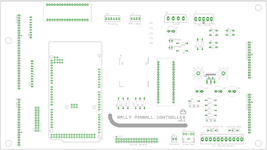Following on from my first revision controller board and the demo i did at play expo last year on how arduino controllers can be used to control early pinball machine playfields i have been working on updated controller board that will fit into bally games from 1976 - 1985 and allow you to create your own rules and game. The idea is that it will connect to the existing wiring in the game and allow you to recreate game rules, or create you own game and control the existing lamps, displays and solenoids. There are plenty of new features on the board to such as
RGB Lamp Control
Serial Displays
SD card sound/music storage
Multiple Channel Sound with background music capability
and there will be a new driver board to which will allow you to control many more devices, add flashers in to the games etc etc.
More details and vids to come. Here is a quick pic of the controller board layout.

RGB Lamp Control
Serial Displays
SD card sound/music storage
Multiple Channel Sound with background music capability
and there will be a new driver board to which will allow you to control many more devices, add flashers in to the games etc etc.
More details and vids to come. Here is a quick pic of the controller board layout.



 this is quite entertaining. i don't understand the finer points of the discussion though, as i saw the working pin at Play 2014 powered by that chip thingy, and i don't remember any switches being missed. did it miss? what is the problem with the idea of using an arduino,
this is quite entertaining. i don't understand the finer points of the discussion though, as i saw the working pin at Play 2014 powered by that chip thingy, and i don't remember any switches being missed. did it miss? what is the problem with the idea of using an arduino, 


